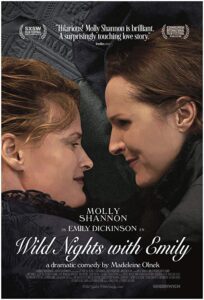Madeleine Olnek’s adaptation of her play gives us a revealing, emotional take on mercurial poet Emily Dickinson.


What we thought we knew about Emily Dickinson was largely untrue. This is the starting point for writer/director Madeleine Olnek’s stagey, but engaging, film “Wild Nights with Emily.” It’s a confoundedly interesting viewing experience—one to be revisited.
As good as Molly Shannon is as the troubled, reclusive poet Dickinson, and as carefully told the story is in Olnek’s movie, the end title sequence is what got to me. It puts context to everything in the quirky film. The mystery is one of perspective in a way, and nothing of a mystery in another; rather, it’s a crime story. And “Wild Nights with Emily” chronicles the criminality.

After Dickinson’s death, at the ripe old age of 55, the Amherst, Massachusetts, poet found fame for her writing, but the exploitation of her work was shown through a distorted lens. Persons in control of her writings changed them, clouding the true meaning and disrupting a legacy that should have been ahead of its time.
In this movie, we see Dickinson in the writing process. This involved putting pencil to paper, and she writes on whatever scraps of paper are available to her. For example, in one scene, a poem is written on the back of a grocery list. And so much of her words are found in correspondence with the love of her life, her sister-in-law Susan (played by Susan Ziegler). And it wasn’t until I realized the crime that was perpetrated against the writer after her death, did Olnek’s movie really come together for me.
Part of the offense here was an inevitable product of the time and place. While this is not excusable, it must be understood. Dickinson was a member of a prominent Amherst family, and her brother, married to Susan, eventually takes up with the ambitious Mabel (played by Amy Seimetz). So, the film is told through both Mabel’s point of view and Emily’s, with Susan’s practical perspective often guiding Emily’s.

Mabel, who publishes Emily’s work after her death, is the one that leads the effort to remove references to Susan. Naturally, a lesbian relationship in 1880s was frowned upon. But when a scientific analysis was done of the actual written pages, the truth is clear, Susan was erased. Perhaps, the country and the world just wasn’t ready for the true focus of Dickinson’s work.
To be entirely accurate, Olnek has made expert use of the original poetry, often having Emily speak the words in voiceover while composing them. In one sequence, she is shown on what is a blacked stage and the words are spoken by Dickinson and an African-American actor. It’s really beautiful, worthy of watching again.

Susan Ziegler is excellent opposite Shannon.
Shannon is great as the affected poet. We meet Dickinson both as a youngster (played by Dana Melanie) and later (as Shannon). Given her SNL background, Shannon brings perfect comic timing to the role, which works well with Olnek’s eclectic screenplay. It’s funny and biting. And as weirdly aloof as Dickinson is depicted here, she’s grounded by Susan. As Susan, Ziegler is Shannon’s straight man, making the heady humor hit hard.
Rewarding in so many ways, “Wild Nights with Emily” gives us a unique perspective on the origins and motivations of one of our most beloved poets. It’s really a wonderful and important film.
